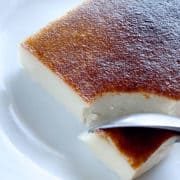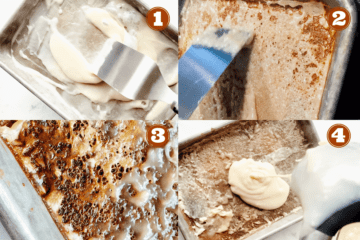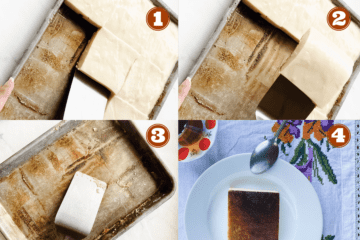Description
This vegan burned pudding tastes identical to the authentic Turkish kazandibi dessert. Earthy caramel flavors from the flames take it to the next level! This is a dessert fit for sultans.
Ingredients
Scale
For a 9-by-13-inch flame-proof pan (see notes for different sizes)
- 1/2 cup (60 g) all-purpose flour
- 3 tablespoon (30 g) rice flour
- 2/3 cup (75 g) cornstarch
- 1 1/2 cups (300 g) granulated sugar
- 6 1/2 cups (1.5 liters) soymilk
- 3/4 cup (150 ml) coconut cream
- 1/2 teaspoon mastic (plant resin), pounded with 1 teaspoon sugar
- optional: 1/2 teaspoon vanilla extract
Instructions
Make the Pudding:
- In a large saucepan, add the AP flour, rice flour, cornstarch, sugar, soymilk, and coconut cream. Mix thoroughly and heat on medium-high until it comes to a boil, continuously stirring.
- Once boiling, add the mastic and vanilla (if using) and reduce heat to low. Simmer for 25-30 minutes, stirring occasionally to ensure there aren't any lumps.
- Make sure to move to the next burning process quickly, as the pudding will set and may get lumpy the longer it sits.
Burn the Bottom:
- Give the tray a quick wash with water right before starting to burn the pudding to make sure the bottom layer doesn't stick. Put the baking pan over a medium-heat burner and place 1-2 cups of the pudding mixture to cover the entire bottom of the pan. Make sure to wear oven mitts and move the pan around to ensure an even burn.
- Use a metal spatula to gently scrape the top to inspect; this will let you see what's happening below the excess pudding. You're looking for a very deep brown, almost black, color all over. The entire process can take 15 to 30 minutes, depending on the level of heat and the material of the pan.
Set & Serve:
- When finished, set the pan aside and add the rest of the pudding mixture over the burned pudding. If there are any lumps, bring the pudding in the pot back to a boil while vigorously mixing, or use an immersion blender. Let cool, then cover and refrigerate for at least 6 hours. Overnight is even better.
- Cut the pudding into squares with a spatula, making sure to graze and lift from the very bottom. Serve each slice cold, burned bottom side up, and sprinkled with cinnamon if preferred.
Notes
- Pan Size: You will need a metal baking pan — no enamel or glass. Aluminum works best. The size of the pan is also very important—the original recipe uses a 9-by-13-inch pan with a 1 1/2-inch lip. You can absolutely use a baking pan (or non-stick pan) of a different size, but need to make sure the total area matches up. For example, the original recipe makes a 1-inch-thick tray of pudding, filling up about 120 square inches. If you're using an 8-by-8-inch, (64 square inches) you may simply halve the ingredients and have the same thickness!
- Non-Stick Pan Method: Place a few ladles of the pudding mixture into the non-stick pan and burn the bottom on medium-high heat. Use a silicone spatula to check the bottom; we want it to turn almost black. This method takes longer (30+ minutes) and the bottom may still not turn the right color.
- Choice of Milk: You may use any plant milk you prefer; unsweetened & unflavored, with no additives will yield the best results. I used Westsoy in which soybeans and water are the only ingredients, and added the coconut cream for extra fat. Keep in mind that classic kazandibi is made with buffalo milk, which is very fatty.
- Gluten-Free: You may substitute the AP flour with store-bought gluten-free flour or rice flour if you wish.
- Mastic: Feel free to skip mastic if you don't have any, the pudding will still turn out delicious! But I'd highly recommend it, you can use mastic in Turkish coffee or ice cream as well.
- Using Sugar to Burn the Bottom: You do not need to coat the bottom of the tray with butter or sugar! There are some recipes or comments that suggest this (even on Turkish websites)—and it is completely wrong. No pastry shop worth their salt in Turkey uses that technique to make kazandibi. It somewhat alters the authentic earthy flavor and really doesn't make the bottom any less sticky.
- Category: Dessert
- Method: Cook
- Cuisine: Turkish



